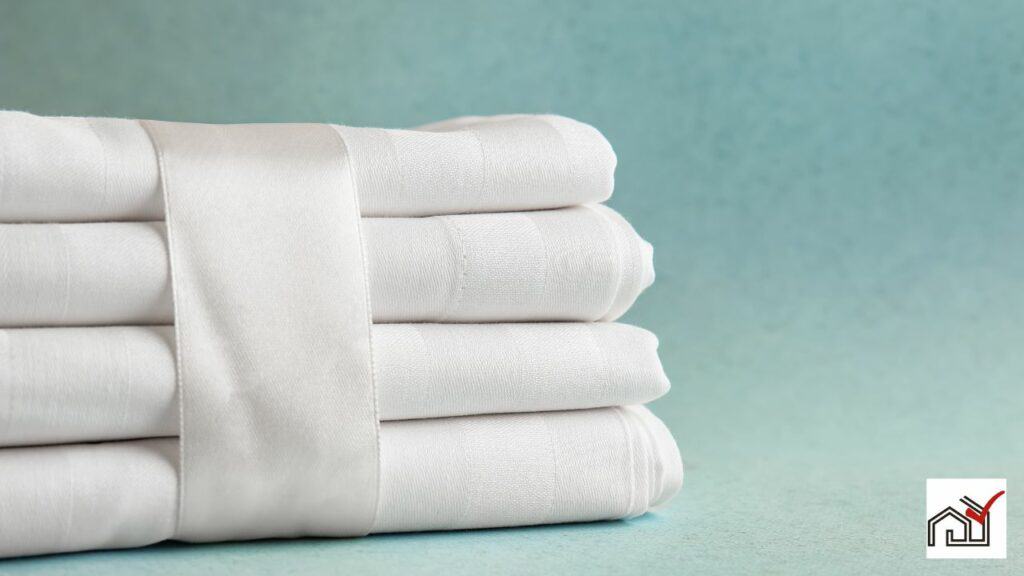The time it takes for bed sheets to dry depends on several factors including the material, drying method, and the environment. Sheets made from natural fibers often dry faster than those made from synthetic materials. If using a tumble dryer, the time will vary based on its settings and the heaviness of the fabric.
Drying sheets outside can be quicker if the weather is warm, less humid, and windy. However, drying indoors typically takes longer and is influenced by the room's airflow and conditions.
It's important to consider these elements to ensure bed sheets dry efficiently and are ready for use again in good condition. This overview highlights key points affecting drying times and offers tips for faster drying.
Factors Affecting Drying Time
The drying time of bed sheets is influenced by several factors. One of these factors is the fabric type. Cotton sheets usually take longer to dry than polyester because cotton holds more moisture.
Another factor is the drying method. Using a tumble dryer on a low heat setting can speed up drying and help avoid damage like fabric pilling. However, tumble dryers can cause wrinkles if sheets are not removed immediately after the cycle.
The use of dryer balls can improve air flow and reduce drying time and wrinkling.
Environmental conditions also play a role in drying time. High humidity can slow down drying, both outdoors and indoors. Thicker materials also dry more slowly in outdoor conditions.
Drying bed sheets separately from other laundry allows for better air circulation, leading to faster and more even drying.
Taking these factors into account can help manage drying times and maintain bed linens.
Drying Sheets Outdoors
Drying bed sheets outside can reduce drying time, especially in good weather. Sun and wind naturally speed up the process. On a sunny, breezy day, sheets can dry in a few hours.
To dry sheets outdoors effectively, hang them to catch the wind. Ensure the open end faces the breeze for better air circulation, which prevents wrinkles and speeds up drying. Secure the sheets on windy days to stop them from blowing away.
Drying time varies with the weather. In ideal conditions, with sun and moderate wind, sheets may dry in 2-3 hours. On cloudy or humid days, it can take over 5 hours. Avoid hanging sheets outside overnight in humid weather, as they may remain damp.
Outdoor sheet drying is efficient and conserves energy when done correctly on suitable days.
Tumble Dryer Considerations
The average drying time for bed sheets in a tumble dryer is 40 to 60 minutes, which varies based on the fabric and heat settings. It's essential to confirm whether bed sheets are suitable for tumble drying by checking the care label to avoid damage.
For effective drying, use a low or medium heat setting. High temperatures can cause shrinkage and fiber damage, shortening the sheets' durability. Delicate fabrics need careful drying to prevent harm. Do not overload the dryer to ensure even drying; dry sheets in separate loads if necessary.
While dryer sheets can provide softness, they are unsuitable for materials like microfiber or certain cottons, as they may harm the fabric. Wool dryer balls are an alternative that softens without chemicals.
Selecting the correct temperature is crucial for bed linen preservation. Always follow the manufacturer's guidelines for the right heat setting. A tumble dryer is useful for quick drying, but proper usage ensures the longevity of your bedding.
Indoor Drying Strategies
To reduce bed sheet drying time indoors, there are several strategies and tools that can be used. One option is to strategically place the sheets and use tools such as fans or heated clothes horses. This can be helpful if a dryer is not available or if air drying is recommended.
To increase air exposure and promote faster drying, it's important to spread out the sheets. Additionally, smaller sheets can be hung on radiators, which can help them dry faster. It's important to ensure good airflow in order to prevent moisture buildup.
If a tumble dryer is not available, using a heated clothes horse can be an effective alternative for drying heavy items like duvets and pillows, as well as cotton sheets that tend to retain more moisture than synthetic materials. It's recommended to avoid mixing bed sheets with other laundry on the clothes horse, as this can decrease drying time.
Another option to improve airflow and reduce drying time is to position a fan near the sheets. This can help to circulate the air and speed up the drying process. Alternatively, partially drying the sheets in a tumble dryer before air drying can also help to decrease drying time.
It's important to follow the care label instructions to prevent any potential fabric damage. By applying these methods, you can ensure that your bed sheets dry efficiently.
Speeding Up the Drying Process
To dry bed sheets more quickly, there are a few strategies you can try. First, if it's a nice day outside, hang the sheets outside in a way that allows the wind to blow through them. This can help speed up the drying process.
If you need to dry the sheets indoors, a fan can be a helpful tool. Use a fan to move air around the sheets and promote moisture evaporation. It's also important to make sure the room is well-ventilated to help with drying.
Before using a tumble dryer, take a moment to spin the sheets in the washing machine. This will help remove excess water and reduce the overall drying time.
When using the tumble dryer, it's best to set it to a moderate heat. Ideally, keep the temperature below 55°C to prevent any potential fabric damage. This can also help minimize wrinkling or shrinking.
It's a good idea to avoid using fabric softeners when drying sheets. While they may make the sheets feel softer, they can also make them less absorbent and prolong drying time.
Lastly, when using a dryer, try to dry cotton sheets separately from other materials. This will help avoid over-drying, save energy, and protect the sheets from potential heat damage.
Sheet Care and Maintenance
To properly care for bed sheets and extend their life, wash them regularly according to the instructions on the care label. Check the label before washing since machine wash settings vary by fabric and brand.
Use the correct heat setting when washing and drying to reduce wear. For example, cotton sheets may need a higher heat setting in the dryer as they retain more moisture than polyester. However, choose the lowest effective heat setting to lessen damage over time.
After washing, fold the sheets neatly to promote even drying and prevent wrinkles. This also helps prevent mildew, which can occur if sheets stay damp too long. Air out your bedding regularly between washes to keep it fresh, especially if you air dry outside.
Proper sheet care ensures a comfortable sleep and prolongs the life of your bedding. Follow washing and drying instructions and handle sheets carefully for the benefit of longevity and faster drying times.





